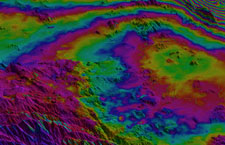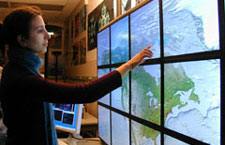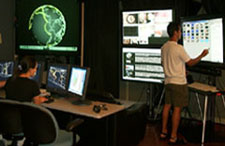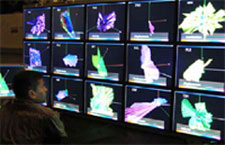The OptIPuter: Bandwidth No Longer the Bottleneck
|
7.15.03 - Moore’s Law has long served as a truism for the field of computing. It predicted that the amount of information that could be stored on a given amount of silicon would roughly double every year. The pace has slowed to doubling every 18 months, but most believe this law will hold true for the foreseeable future.
Moore's Law powered the dreams of computing, while the constraints of networking tried to hold them in check. This "world view" has dominated the design of computing, networking, storage, and visualization architectures for more than 35 years, prefiguring what has - or, perhaps, more importantly, has not - been possible.
But, with the advent of optical networking, the exponential growth rate in bandwidth has crossed over and will continue to exceed that of Moore's Law, enabling a new world view in which the central architectural element is not the computer platform but optical networking.
As happened a decade ago in supercomputing, this transition is made possible by the use of parallelism. But this time, parallelism takes the form of multiple wavelengths of light, or lambdas, capable of traversing single optical fibers. Staying true to the analogy with supercomputers, the result is supernetworks.
|
In this context, the OptIPuter project, funded by NSF through its Information Technology Research program, is exploring a new architecture for distributed information infrastructure. This architecture is motivated by a number of emerging large-scale, shared, science and engineering systems. It aims to learn how, as George Gilder suggests, to "waste" bandwidth and storage so as to conserve "scarce" computing in this new world of literally inverted values.
OptIPuter, the name, is based on "opt" from optical networking, "IP" for Internet Protocol (from TCP/IP, a protocol enabling transmission of data between computers on the Internet), and "uter" leveraging the suffix of the word "computer."
OptIPuter is driven by close collaborations with two community systems – NSF’s EarthScope and NIH’s Biomedical Informatics Research Network (BIRN). Both are beginning to produce an accelerating flood of data stored in distributed, federated data repositories. The progress of their science has been hampered because the individual data objects (a 3-D brain image or terrain data set) are too large (Gigabytes in size) compared to the sizes that can be manipulated or visualized interactively over today’s networks.
What these scientists require - and what OptIPuter expects to prototype - are ultra-high-speed, predictable, "clear-channel" networks linking PC clusters, storage, and visualization systems, which will enable collaboration on massive amounts of previously uncorrelated data. We believe this will be possible by enabling lambda paths to form uncongested networks the full distance from source to destination.
The OptIPuter can be seen as a "virtual" parallel computer in which the individual "processors" are widely distributed clusters; the backbone network is provided by IP delivered over multiple dedicated lambdas (each 1-10 Gbps); and, the "mass storage systems" are large distributed scientific data repositories, fed by scientific instruments as near-real-time peripheral devices.
Currently developing a working prototype for its partners and collaborators to become available later this summer, the OptIPuter team plans workshops and friendly competitions that will challenge the most demanding national and international applications to use the OptIPuter architecture most effectively.
|
Collaboration is also a defining OptIPuter characteristic. The OptIPuter team plans to implement a next-generation collaboration environment, called the Continuum, that supports tiled, 3-D stereo, HDTV-resolution screens for streaming large-scale computer graphics simulations and processed data from federated data repositories, instrumentation, and next-generation teleconferencing systems – all over optical multicast. OptIPuter collaborative visualization centers will serve as enabling technologies for broader societal needs, including emergency response, homeland security, health services, and science education.
Some people believe this research belongs “somewhere over the rainbow.” But in fact this new paradigm of “bandwidth no longer being the bottleneck” will be stress tested by large-scale, application-driven system experiments.
The OptIPuter is an embodiment of the vision of "hollowing out of the computer" prophesied by Erich Schmidt in the mid-1990s. Just as in the old Jack-in-the-Box commercials, the old "computer-in-a-box" is being blown up and scattered across the Net. The result will be more powerful capabilities to support large-scale, federally funded, networked research activities.
About OptIPuter
The OptIPuter is a five-year, $13.5-million project funded by the National Science Foundation, which started in October 2002. It will enable scientists who are generating massive amounts of data to interactively visualize, analyze, and correlate their data from multiple storage sites connected via optical networks. UCSD and UIC lead the research team, with academic partners at Northwestern University, San Diego State University, the Information Sciences Institute at the University of Southern California, and UC Irvine; affiliate partners at the U.S. Geological Survey EROS Data Center and the University of Amsterdam; and, industrial partners IBM, Telcordia Technologies, Inc., and Chiaro Networks.
For more information, see www.optiputer.net
|
|





